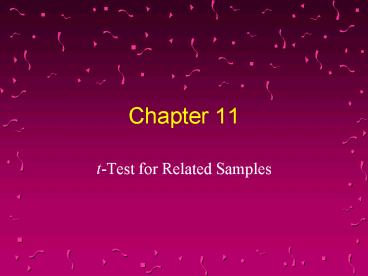tTest for Related Samples - PowerPoint PPT Presentation
1 / 23
Title:
tTest for Related Samples
Description:
Assessing the effectiveness of a therapy by assessing a group of individuals ... the therapy and then assessing the same individuals after they had the therapy. ... – PowerPoint PPT presentation
Number of Views:125
Avg rating:3.0/5.0
Title: tTest for Related Samples
1
Chapter 11
- t-Test for Related Samples
2
Related Samples
When the observations in one sample are clearly
related to the observations in a second sample,
the two samples are related.
3
Examples of Related Samples
- Assessing the effect of practice by testing a
group of people before they practiced a skill and
then testing the same group of people after they
had tested the skill. - Assessing the effectiveness of a therapy by
assessing a group of individuals before they
received the therapy and then assessing the same
individuals after they had the therapy.
4
The logic of hypothesis testing with related
samples is essentially the same as before. We
look at the difference between the two sample
means and determine how likely it was to have
obtained that difference if the null hypothesis
was true. If it was unlikely (i.e., p lt .05), we
reject the null hypothesis.
5
Computationally, the procedure with related
samples is much simpler than with independent
samples. In fact, it is computationally
equivalent to the single sample case.
6
The trick is to take the difference between
related scores. This converts two sets of scores
(one set for each sample) into a single set of
scores. We can then treat it as a single sample.
7
Example
Suppose I am interested in the effect of
repetition on memory. Therefore, I present a
list of words to participants and immediately
test their recall of the words. I then present
the list for a second time followed immediately
by a second test. By comparing the scores on the
first test to the second test, I can hope to see
the effect of repetition.
8
Data
9
The first step is to take the difference between
each pair of related scores
10
The first step is to take the difference between
each pair of related scores
Notice that the difference between the two sample
means equals the mean difference.
11
We then determine how likely it would be to
obtain that mean difference if the null
hypothesis was true.
12
The Null and Alternative Hypotheses
13
To determine the likelihood of having obtained
that mean difference when the null hypothesis is
true, we have to rely on the sampling
distribution of the mean difference.
14
The sampling distribution of the mean difference
15
The sampling distribution of the mean difference
has the following characteristics
16
sD is the estimated standard deviation of the
population of difference scores
Note this is the same as the forumula for the
sample standard deviation.
17
We apply the same decision rule
If the mean difference falls outside of the 95
confidence interval we reject the null
hypothesis.
18
We apply the same decision rule
If the mean difference falls outside of the 95
confidence interval we reject the null
hypothesis. This is determined by calculating a
t score for the mean difference and comparing it
to the critical values of t that define the 95
confidence interval
19
The t score formula
Which can be simplified to
20
Computations
21
In this example, the critical values of t when
alpha .05 are 2.571 and -2.571. Since our
calculated value of t falls outside of this
range, we reject the null hypothesis. The
likelihood of making a type I error is less than
1 (i.e., p lt .01).
22
Summary of steps for t test for related samples
- State the null and alternative hypotheses
- Compute the difference between each pair of
related scores - Compute the mean and sample standard deviation
for this sample of difference scores - Compute the standard error of the mean difference
- Compute the t score for the mean difference
- Obtain the critical values of t when alpha .05
- Apply the decision rule
- If you reject the null hypothesis, determine the
likelihood of having obtained a type I error.
23
A final note
Because the amount of sampling error is typically
less when you have related samples than when you
have independent samples, a difference is more
likely to be significant (i.e., the null
hypothesis is more likely to be rejected) with
related samples. Therefore, if the situation
warrants it, researchers tend to prefer to use
related samples.































